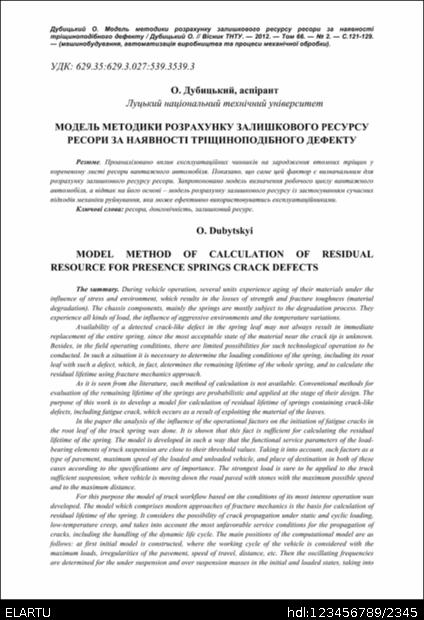Empreu aquest identificador per citar o enllaçar aquest ítem:
http://elartu.tntu.edu.ua/handle/123456789/2345

| Títol: | Модель методики розрахунку залишкового ресурсу ресори за наявності тріщиноподібного дефекту |
| Altres títols: | Model method of calculation of residual resource for presence springs crack defects |
| Autor: | Дубицький, Олександр Сергійович Dubytskyi, O. |
| Bibliographic description (Ukraine): | Дубицький О. Модель методики розрахунку залишкового ресурсу ресори за наявності тріщиноподібного дефекту / Дубицький О. // Вісник ТНТУ. — 2012. — Том 66. — № 2. — С.121-129. — (машинобудування, автоматизація виробництва та процеси механічної обробки). |
| Data de publicació: | 23-d’a-2012 |
| Date of entry: | 26-de -2013 |
| Editorial: | Тернопільський національний технічний університет ім. Івана Пулюя |
| Place of the edition/event: | Тернопіль, Україна |
| UDC: | 629.35 629.3.027 539.3539.3 |
| Paraules clau: | ресора довговічність залишковий ресурс spring durability remaining life |
| Resum: | Проаналізовано вплив експлуатаційних чинників на зародження втомних тріщин у кореневому листі ресори вантажного автомобіля. Показано, що саме цей фактор є визначальним для розрахунку залишкового ресурсу ресори. Запропоновано модель визначення робочого циклу вантажного автомобіля, а відтак на його основі – модель розрахунку залишкового ресурсу із застосуванням сучасних підходів механіки руйнування, яка може ефективно використовуватись експлуатаційниками. During vehicle operation, several units experience aging of their materials under the influence of stress and environment, which results in the losses of strength and fracture toughness (material degradation). The chassis components, mainly the springs are mostly subject to the degradation process. They experience all kinds of load, the influence of aggressive environments and the temperature variations. Availability of a detected crack-like defect in the spring leaf may not always result in immediate replacement of the entire spring, since the most acceptable state of the material near the crack tip is unknown. Besides, in the field operating conditions, there are limited possibilities for such technological operation to be conducted. In such a situation it is necessary to determine the loading conditions of the spring, including its root leaf with such a defect, which, in fact, determines the remaining lifetime of the whole spring, and to calculate the residual lifetime using fracture mechanics approach. As it is seen from the literature, such method of calculation is not available. Conventional methods for evaluation of the remaining lifetime of the springs are probabilistic and applied at the stage of their design. The purpose of this work is to develop a model for calculation of residual lifetime of springs containing crack-like defects, including fatigue crack, which occurs as a result of exploiting the material of the leaves. In the paper the analysis of the influence of the operational factors on the initiation of fatigue cracks in the root leaf of the truck spring was done. It is shown that this fact is sufficient for calculating the residual lifetime of the spring. The model is developed in such a way that the functional service parameters of the load-bearing elements of truck suspension are close to their threshold values. Taking it into account, such factors as a type of pavement, maximum speed of the loaded and unloaded vehicle, and place of destination in both of these cases according to the specifications are of importance. The strongest load is sure to be applied to the truck sufficient suspension, when vehicle is moving down the road paved with stones with the maximum possible speed and to the maximum distance. For this purpose the model of truck workflow based on the conditions of its most intense operation was developed. The model which comprises modern approaches of fracture mechanics is the basis for calculation of residual lifetime of the spring. It considers the possibility of crack propagation under static and cyclic loading, low-temperature creep, and takes into account the most unfavorable service conditions for the propagation of cracks, including the handling of the dynamic life cycle. The main positions of the computational model are as follows: at first initial model is constructed, where the working cycle of the vehicle is considered with the maximum loads, irregularities of the pavement, speed of travel, distance, etc. Then the oscillating frequencies are determined for the under suspension and over suspension masses in the initial and loaded states, taking into account the above mentioned factors. Then a set of working basic service parameters are determined for the root leaves of the springs based on the time of operation. Using the approaches of linear fracture mechanics, the remaining lifetime is calculated for such leaves containing a half-disk of half-elliptic cracks detected during the in-service inspection of the vehicle. For this purpose the time for fatigue crack propagation has to be determined for cyclic loading under maximum possible level, with prior determination of its cyclic and static fracture toughness. If a durable parking of the loaded vehicle is expected, evaluation of the influence of static loading on toughness of the spring leaf to the load and the crack propagation rate under low-temperature creep conditions should be carried out. |
| URI: | http://elartu.tntu.edu.ua/handle/123456789/2345 |
| ISSN: | 1727-7108 |
| Copyright owner: | © „Вісник Тернопільського національного технічного університету“ |
| Publications status : | Опубліковано раніше |
| Content type: | Article |
| Apareix a les col·leccions: | Вісник ТНТУ, 2012, № 2 (66) |
Arxius per aquest ítem:
Els ítems de DSpace es troben protegits per copyright, amb tots els drets reservats, sempre i quan no s’indiqui el contrari.